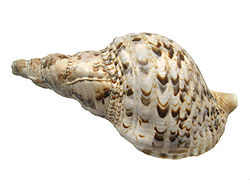
Charonia tritonis
Encyclopedia
Charonia tritonis, common name Triton's trumpet, is a species
of very large sea snail
, a marine
gastropod mollusc in the family
Ranellidae
, the tritons.
Also see Charonia or Triton (mollusk)
.
oceans.

).
C. tritonis is one of the few animals that feeds on the crown-of-thorns starfish, Acanthaster planci.
Occasional plagues of this large and destructive starfish have killed extensive areas of coral on the Great Barrier Reef
of Australia and the western Pacific reefs. There has been much debate on whether such plagues are natural or are caused by over-fishing of the few mollusks and fish that can eat this starfish.
In 1994, Australia proposed that Charonia tritonis should be put on the CITES list, thereby attempting to protect the species.
Because of a lack of trade data concerning this seashell, the Berne Criteria from CITES were not met and the proposal was consequently withdrawn.
http://www.cites.org/eng/cop/09/e9-comi.pdf
Species
In biology, a species is one of the basic units of biological classification and a taxonomic rank. A species is often defined as a group of organisms capable of interbreeding and producing fertile offspring. While in many cases this definition is adequate, more precise or differing measures are...
of very large sea snail
Snail
Snail is a common name applied to most of the members of the molluscan class Gastropoda that have coiled shells in the adult stage. When the word is used in its most general sense, it includes sea snails, land snails and freshwater snails. The word snail without any qualifier is however more often...
, a marine
Marine (ocean)
Marine is an umbrella term. As an adjective it is usually applicable to things relating to the sea or ocean, such as marine biology, marine ecology and marine geology...
gastropod mollusc in the family
Family (biology)
In biological classification, family is* a taxonomic rank. Other well-known ranks are life, domain, kingdom, phylum, class, order, genus, and species, with family fitting between order and genus. As for the other well-known ranks, there is the option of an immediately lower rank, indicated by the...
Ranellidae
Ranellidae
Ranellidae, common name the triton shells or tritons, is a taxonomic family of small to very large predatory sea snails, marine gastropod mollusks in the clade Littorinimorpha.-Subfamilies:...
, the tritons.
Also see Charonia or Triton (mollusk)
Triton (mollusk)
Triton is the common name given to a number of very large sea snails, predatory marine gastropods in the genus Charonia. The name "triton" is also often applied as part of the common name, to other, much smaller sea snails of other genera within the same family, Ranellidae.Tritons are named after...
.
Distribution
This species is found throughout the Indo-PacificIndo-Pacific
The Indo-Pacific is a biogeographic region of the Earth's seas, comprising the tropical waters of the Indian Ocean, the western and central Pacific Ocean, and the seas connecting the two in the general area of Indonesia...
oceans.

Human use
The shell is well-known as a decorative object, and is sometimes modified for use as a trumpet (such as the Japanese horagaiHoragai
' are large conch shells that have been used as a trumpets in Japan for many centuries. The instrument, which has served a number of purposes throughout Japanese history, has been given a number of Japanese names depending on its function...
).
C. tritonis is one of the few animals that feeds on the crown-of-thorns starfish, Acanthaster planci.
Occasional plagues of this large and destructive starfish have killed extensive areas of coral on the Great Barrier Reef
Great Barrier Reef
The Great Barrier Reef is the world'slargest reef system composed of over 2,900 individual reefs and 900 islands stretching for over 2,600 kilometres over an area of approximately...
of Australia and the western Pacific reefs. There has been much debate on whether such plagues are natural or are caused by over-fishing of the few mollusks and fish that can eat this starfish.
In 1994, Australia proposed that Charonia tritonis should be put on the CITES list, thereby attempting to protect the species.
Because of a lack of trade data concerning this seashell, the Berne Criteria from CITES were not met and the proposal was consequently withdrawn.
External links
http://na.oceana.org/en/explore/creatures/crown-of-thorns-starfishhttp://www.cites.org/eng/cop/09/e9-comi.pdf

